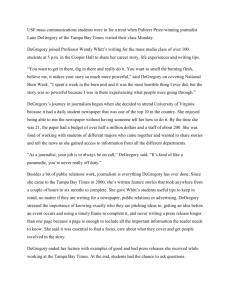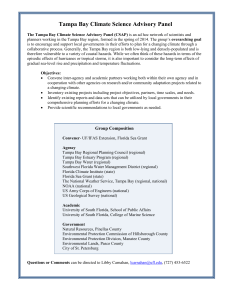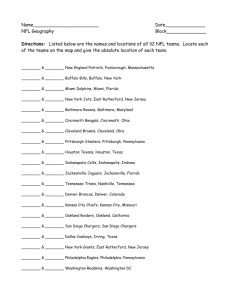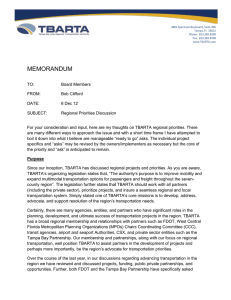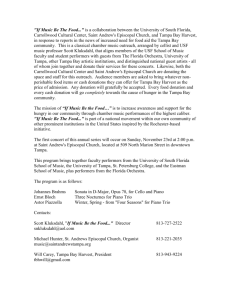JOINT MEETING AGENDA TBRPC AGENCY ON BAY MANAGEMENT TBEP TECHNICAL ADVISORY COMMITTEE
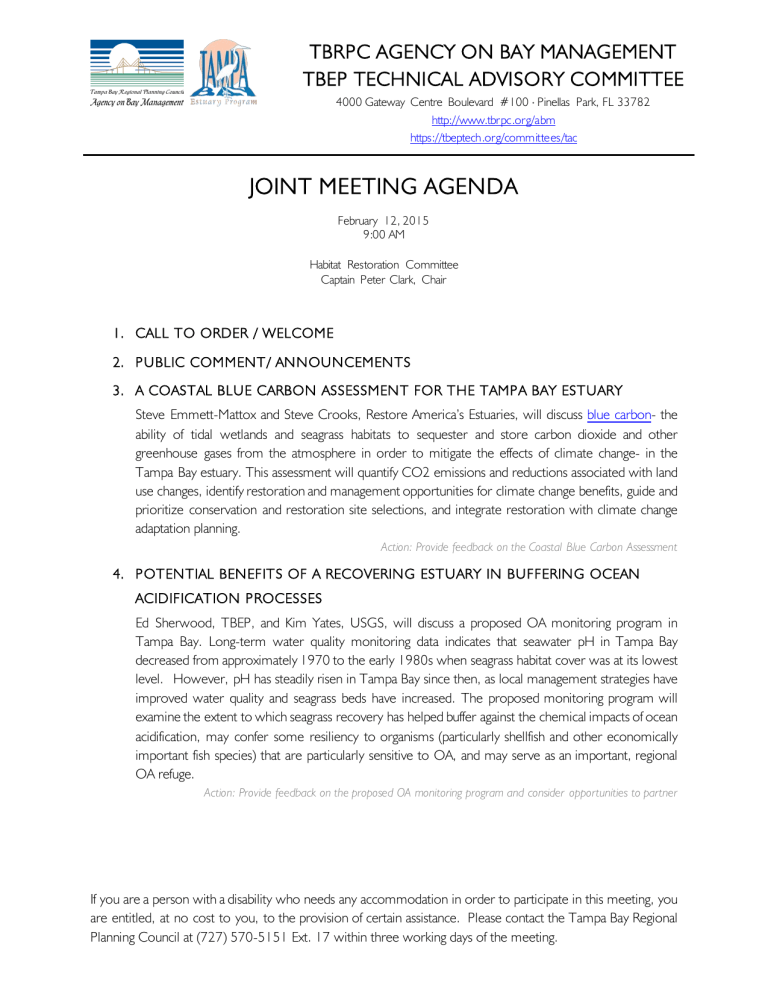
TBRPC AGENCY ON BAY MANAGEMENT
TBEP TECHNICAL ADVISORY COMMITTEE
4000 Gateway Centre Boulevard #100 ⋅ Pinellas Park, FL 33782 http://www.tbrpc.org/abm https://tbeptech.org/committees/tac
JOINT MEETING AGENDA
February 12, 2015
9:00 AM
Habitat Restoration Committee
Captain Peter Clark, Chair
1.
CALL TO ORDER / WELCOME
2.
PUBLIC COMMENT/ ANNOUNCEMENTS
3.
A COASTAL BLUE CARBON ASSESSMENT FOR THE TAMPA BAY ESTUARY
Steve Emmett-Mattox and Steve Crooks, Restore America’s Estuaries, will discuss blue carbon - the ability of tidal wetlands and seagrass habitats to sequester and store carbon dioxide and other greenhouse gases from the atmosphere in order to mitigate the effects of climate change- in the
Tampa Bay estuary. This assessment will quantify CO2 emissions and reductions associated with land use changes, identify restoration and management opportunities for climate change benefits, guide and prioritize conservation and restoration site selections, and integrate restoration with climate change adaptation planning.
Action: Provide feedback on the Coastal Blue Carbon Assessment
4.
POTENTIAL BENEFITS OF A RECOVERING ESTUARY IN BUFFERING OCEAN
ACIDIFICATION PROCESSES
Ed Sherwood, TBEP, and Kim Yates, USGS, will discuss a proposed OA monitoring program in
Tampa Bay. Long-term water quality monitoring data indicates that seawater pH in Tampa Bay decreased from approximately 1970 to the early 1980s when seagrass habitat cover was at its lowest level. However, pH has steadily risen in Tampa Bay since then, as local management strategies have improved water quality and seagrass beds have increased. The proposed monitoring program will examine the extent to which seagrass recovery has helped buffer against the chemical impacts of ocean acidification, may confer some resiliency to organisms (particularly shellfish and other economically important fish species) that are particularly sensitive to OA, and may serve as an important, regional
OA refuge.
Action: Provide feedback on the proposed OA monitoring program and consider opportunities to partner
If you are a person with a disability who needs any accommodation in order to participate in this meeting, you are entitled, at no cost to you, to the provision of certain assistance. Please contact the Tampa Bay Regional
Planning Council at (727) 570-5151 Ext. 17 within three working days of the meeting.
TBRPC AGENCY ON BAY MANAGEMENT
TBEP TECHNICAL ADVISORY COMMITTEE
4000 Gateway Centre Boulevard #100 ⋅ Pinellas Park, FL 33782 http://www.tbrpc.org/abm https://tbeptech.org/committees/tac
5.
CLIMATE CHANGE ARCTIC PROGRAM
Dr. George Atkinson, Institute on Science for Global Policy, will provide an overview of the Climate
Change Arctic Program . St. Petersburg has been selected as one of 20 communities to participate in a program designed to promote community discussions regarding the mitigation of and adaptation to the local effects of climate change. The program is organized in four stages: survey/data collection , community-wide meetings, a sailing expedition, and reports of lessons learned from the expedition voyage.
Action: None. Information only.
6.
TBEP COMPREHENSIVE CONSERVATION AND MANAGEMENT PLAN UPDATE
Nanette O’Hara, TBEP, will summarize the process and timeline for revising the CCMP and share staff recommendations regarding changes to the CCMP goals.
Action: Provide feedback on proposed revisions to CCMP goals
7.
OTHER ITEMS
⋅ ONE BAY Resilient Communities/ DHS Infrastructure Resilience to Climate Change Exercise
8.
ADJOURN
If you are a person with a disability who needs any accommodation in order to participate in this meeting, you are entitled, at no cost to you, to the provision of certain assistance. Please contact the Tampa Bay Regional
Planning Council at (727) 570-5151 Ext. 17 within three working days of the meeting.
Assessing the Blue Carbon Benefits of
Habitat Restoration in Tampa Bay
Project Title: A “Coastal Blue Carbon” Assessment of the Tampa Bay Estuary: Accounting for the Climate Change Mitigation Benefits of Integrated Climate Change Adaptation and
Ecosystem Restoration in Tampa Bay
Project Summary:
The project will determine the past and potential future climate mitigation benefits of blue carbon ecosystem restoration and conservation in the Tampa Bay estuary. The assessment is an important part of a strat egic effort by Restore America’s Estuaries to increase our understanding of the climate mitigation and adaptation benefits of estuary habitat restoration and conservation.
It will utilize a transferrable approach and model recently developed for the Snohomish estuary in Washington. This assessment will make a significant contribution to the field of blue carbon research and support coastal managers and policy makers globally.
Project period: October 2014 – December 2015.
Project goals: o Quantify the carbon dioxide emissions and reductions associated with past land use changes and current restoration and conservation goals o Identify opportunities for enhanced coastal ecosystem management, including restoration, for climate change benefits o Provide guidance for priority conservation and restoration site selection o Integrate restoration with climate change adaptation planning to preserve the carbon and other ecosystem benefits of these habitats o Support increased investment in habitat restoration and coastal adaptation
What is “ coastal blue carbon ”? – It refers to the carbon captured and stored by coastal ecosystems. Tampa Bay is an estuary of national significance and Florida’s largest open water estuary. It is one of the few estuaries in the U.S. containing all t hree “blue carbon” habitats: salt marshes, mangroves, and seagrasses. These habitats absorb large quantities of the greenhouse gas (GHG) carbon dioxide from the atmosphere and store it within biomass and soils, thus decreasing the amount of carbon pollution in the atmosphere.
As efforts to mitigate GHG emissions have increased, much of the science and practice of biological carbon sequestration and the development of carbon offset projects has focused on forestry. There is now strong scientific evidence of the carbon storage and sequestration capacities of coastal wetlands. Peer-reviewed scientific literature has demonstrated the great significance of these ecosystems for both carbon sequestration and storage (Pendleton et al., 2012; Fourqurean et al, 2012).
This project will further develop a replicable approach for blue carbon restoration projects in other estuary regions of the U.S. and the world, provide the science needed to estimate carbon sequestration and storage rates in Tampa Bay, and support increased investment in coastal wetland restoration.
Partners:
The project budget is $250,000 with funding provided through a challenge grant from the Tampa
Bay Environmental Restoration Fund (TBERF), with additional support from NOAA’s Office of
Habitat Conservation and the U.S Fish and Wildlife Service – Coastal Program.
Contact: Steve Emmett-Mattox, sem@estuaries.org
, 720-300-3139
Examining Ocean Acidification in Tampa Bay: Conceptual Approach and Next Steps
DRAFT- Updated Oct 29 2014
Kimberly Yates, USGS, St. Petersburg, FL
Holly Greening, Ed Sherwood, Tampa Bay Estuary Program, St. Petersburg, FL
Miles Croom, Mark Sramek, NOAA Restoration Center, St. Petersburg, FL
Beth Turner, NOAA National Centers for Coastal Ocean Science, Durham, NC
Tom McGill, Felicia Burks, Jennifer Derby, Gary Collins, EPA Region 4, Atlanta GA
Tom Ash, Dave Karlen, Environmental Protection Commission of Hillsborough County, Tampa, FL
Amber Whittle, Ryan Moyer, FWC FWRI, St. Petersburg, FL
Kris Kaufman, Southwest Florida Water Management District, Tampa, FL
Paul Cough, Brian Rappoli, Bob Benson, Hugh Sullivan, EPA OWOW, Washington D.C.
Marc Russell, EPA ORD, Gulf Breeze, FL
Jason Grear, EPA ORD, Northeast Lab, Narragansett MA
Cheryl Brown, EPA ORD, Northwest Lab, Corvalis, OR
Others….
BACKGROUND:
The IPCC has confirmed that ocean acidification (OA) has a profound effect on ocean and coastal ecosystems and communities around the globe (IPCC, 2014). Many marine and estuarine species will be negatively impacted (Gazeau et al., 2007; Fabry et al., 2008; Kurihara, 2008;
Kroecker et al., 2010; Narita et al., 2012), and it is projected that some species (especially calcifying species) may become locally and/or globally extinct. Management strategies have focused on reducing local stressors to reduce the impact of multiple stressors on ecosystems, and on identifying and establishing protected areas with environmental conditions that promote resiliency to marine organisms (Salm et al., 2006).
Long-term water quality monitoring data from the Environmental Protection Commission of Hillsborough County (EPC-HC: http://www.epchc.org/index.aspx?nid=219) indicates that seawater pH in Tampa Bay decreased from approximately 1970 to the early 1980s when seagrass habitat cover was at its lowest level. However, pH has steadily risen in Tampa Bay since then, as local management strategies have improved water quality and seagrass beds have increased
(Greening et al. 2014). Seagrasses are projected to benefit from elevated atmospheric pCO
2
(Kleypas and Yates, 2009), are capable of increasing seawater pH and carbonate mineral saturation states through photosynthesis, and may help provide protection to organisms living in close association with seagrass beds (Manzello et al., 2012).
We hypothesize that the recovery of seagrass in Tampa Bay has helped buffer against the chemical impacts of ocean acidification, may confer some resiliency to organisms (particularly shellfish and other economically important fish species) that are particularly sensitive to OA, and may serve as an important, regional OA refuge. To further examine this hypothesis, we would like to discuss beginning an OA monitoring program in Tampa Bay through supplementing EPCHC’s existing monthly water quality monitoring program with water sampling for measurement of carbon system parameters that enable determination of key parameters such as water column carbonate mineral saturation state, pCO
2
, distribution of carbonate species, and validation of pH measurements using best practice methods (Dickson et al., 2007). Additionally, we’d like to discuss how we might collaborate in evaluating the role of seagrass beds in maintaining/elevating pH and carbonate mineral saturation state through monitoring of carbonate system parameters and pH in representative habitats of Tampa Bay including seagrass beds, sand bottom communities, mangrove communities, oyster beds, and other relevant habitat types. Results from these studies could be useful to inform the FWC-FWRI for examining the implications for Tampa Bay shellfish
populations; the NOAA Restoration Center for identification of potential habitat protection and restoration activities; and EPA for ocean acidification and blue carbon assessment.
NEXT STEPS identified on October 29, 2014
Following discussions by participants from FWC, USGS, TBEP, EPC and EPA on October 29, several next steps were identified. Findings discussed included:
1. Tampa Bay may be unique in that the lower portions of the bay have higher concentrations of carbonate sediments, while the upper portions are primarily siliciclastic sediments—thus providing an opportunity to evaluate acidification issues in both types of systems along a gradient of carbonate levels.
2. The USGS carbonate laboratory in St. Pete is capable of high resolution measurement of carbonate system parameters and has completed international cross-validation exercises with other leading carbon laboratories thus ensuring comparability with other laboratories around the nation and world.
3. Tampa Bay has maintained long-term databases of water quality, benthos, fisheries and seagrass, allowing us to assess trends.
4. The National Coastal Assessment Program has been working on OA indicators for some time.
Work on OA in Tampa Bay could support EPA’s development of indicators.
5. FWC-FWRI is working with YSI and USGS to calibrate autonomous sensors in Clam Bayou that may benefit long-term OA monitoring programs.
NEXT STEPS:
1. Consider assessing existing databases for potential OA impacts, including:
- Benthic database 1993-present (Tom- EPC)
- Seagrass transect data (Ed- TBEP)
2. Overlay seagrass coverage map on sediment carbonate map and EPC long-term water quality sites to identify potential sampling locations for additional measurements noted above. (Ed- TBEP will generate map). Ideally, sampling locations should include sites with seagrass-high carbonate; no seagrass-high carbonate; seagrass- siliciclastic; and no seagrass- siliciclastic characteristics, and/or other sites of interest.
3. Convene working group on Nov 18 th 1 p.m. at the Regional Planning Council (gotomymeeting available also) to discuss monitoring objectives and design, funding needed and available, and logistics.
4. Paul Cough (EPA) will work with Amber Whittle (FWC) to discuss possible National Coastal
Assessment links with Tampa Bay’s work. Paul will also contact the ORD NW Lab and NE Labs to see how we can best work together on some of the national OA issues.
References
Fabry, V.J., Seibel, B.A., Feely, R.A., and Orr, J.C. 2008. Impacts of ocean acidification on marine fauna and ecosystem processes. ICES Journal of Marine Science 65:414-432.
Dickson, A.G., Sabine, C.L., and Christian, J.R. (Eds.). 2007. Guide to best practices for ocean acidification CO
2 measurements. PICES Special Publication 3, 191pp.
Gazeau, F., Quiblier, C., Jansen, J.M., Gattuso, J.-P., Middleburg, J.J., and Heip, C.H.R. 2007. Impact of elevated
CO2 on shellfish calcification. Geophysical Research Letters 34, L07603, doi:10.1029/2006GL028554.
Greening, H., T. Janicki, E. Sherwood, R. Pribble and JOR Johansson. 2014. Ecosystem responses to long-term nutrient management in an urban estuary: Tampa Bay, Florida, USA. Estuarine, Coastal and Shelf Science.
IPCC. 2014: Climate Change 2014: Impacts, Adaptation, and Vulnerability. Part A: Global and Sectoral Aspects.
Contribution of Working Group II to the Fifth Assessment Report of the Intergovernmental Panel on Climate
Change [Field, C.B., V.R. Barros, D.J. Dokken, K.J. Mach, M.D. Mastrandrea, T.E. Bilir, M. Chatterjee, K.L.
Ebi, Y.O. Estrada, R.C. Genova, B. Girma, E.S. Kissel, A.N. Levy, S. MacCracken, P.R. Mastrandrea, and L.L.
White (eds.)]. Cambridge University Press, Cambridge, United Kingdom and New York, NY, USA, XXX pp.
Kleypas, J.A. and Yates, K.K. 2009. Coral reefs and ocean acidification. Oceanography 22(4):108-117.
Kroecker, K.J., Kordas, R.L., Crim, R.N., and Singh, G.G. 2010. Meta-analysis reveals negative yet variable effects of ocean acifidification on marine organisms. Ecology Letters 13:1419-1434.
Kurihara, H. 2008. Effects of CO
2
-driven ocean acidification on the early developmental stages of invertebrates.
Marine Ecology Progres Series 373:275-284.
Manzello, D. P., Enochs, I. C., Melo, N., Gledhill, D. K., and Johns, E. M. 2012. Ocean acidification refugia of the Florida Reef Tract, PLoS ONE, 7, e41715, doi:10.1371/journal.pone.0041715.
Narita, D., Rehdanz, K., and Tol, R.S.J. 2012. Economic costs of ocean acidification: a look into the impacts on global shellfish production. Climatic Change 113:1049-1063.
Salm, R. V., Done, T., and Mcleod, E. 2006. Marine protected area planning in a changing climate, in:
Coral Reefs and Climate Change: Science and Management, American Geophysical Union, Washington, DC, pp. 207-221.
Timeline for Review and Revision of Charting The Course: The
Comprehensive Conservation and Management Plan for Tampa Bay
February 2015
Review of preliminary assessment of goals and actions for inclusion (new, ongoing and retired)
March 2015
Assignment of Actions to be updated by Contractor and TBEP Public Outreach Coordinator in
Fish and Wildlife/Invasive Species Action Plans (total of 7-8 actions)
May 2015
DRAFT Fish and Wildlife/Invasive Species Action Plans available for review
Assignment of Actions to be updated by Contractor and TBEP Public Outreach Coordinator in
Climate Change Action Plan (total of 3 actions)
August 2015
TBEP Management and Policy Boards to review and approve Fish and Wildlife/Invasive Species
Action Plans
DRAFT Climate Change Action Plan available for review
Assignment of Actions to be updated by Contractor and TBEP Public Outreach Coordinator in
Bay Habitats Action Plan (total of 6-7 actions)
November 2015
TBEP Management and Policy Boards to review and approve Climate Change Action Plan
DRAFT Bay Habitats Action Plan available for review
Assignment of Actions to be updated by Contractor and TBEP Public Outreach Coordinator in
Dredging and Dredged Material Management and Spill Prevention and Response Action Plan
(total of 4 actions)
February 2016
TBEP Management and Policy Boards to review and approve Bay Habitats Action Plan
DRAFT Dredging and Dredged Material Management and Spill Prevention and Response Action
Plans available for review
Assignment of Actions to be updated by Contractor and TBEP Public Outreach Coordinator in
Water and Sediment Quality Action Plan (16-17 actions)
May 2016
TBEP Management and Policy Boards to review and approve Dredging and Spill Prevention
Action Plans
DRAFT Water and Sediment Quality Action Plan available for review
Assignment of Actions to be updated by Contractor and TBEP Public Outreach Coordinator in
Public Education and Involvement Action Plan (2 actions)
August 2016
TBEP Management and Policy Boards to review and approve Water and Sediment Quality
Action Plan
DRAFT Public Education and Involvement Action Plan available for review
Assignment of Actions to be updated by Contractor and TBEP Public Outreach Coordinator in
Public Access Action Plan (3 actions)
November 2016
TBEP Management and Policy Boards to review and approve Public Education and Involvement
Action Plan
DRAFT Public Access Action Plan available for review
February 2017
TBEP Management and Policy Boards to review and approve Public Access Action Plan
This is the final Action Plan to be reviewed and approved.
** Additional elements of the CCMP, such as Implementation and Financing and Research and
Monitoring Priorities, also will be brought to the Management and Policy Boards for approval during the May 2015-November 2016 timeframe.
2006 CCMP Goal
Preventing increases in the bay’s nitrogen levels to provide water clarity sufficient to recover 10,976 acres of seagrass. To accomplish this, local governments and industries will need to reduce their future nitrogen contributions to the bay by about 7% by the year 2010, or approximately 17 tons per year.
Reducing the amount of toxic chemicals in contaminated bay sediments and protecting relatively clean areas of the bay from contamination.
Understanding and addressing the sources and impacts of air pollution on the bay’s water quality.
Reducing bacterial contamination now present in the bay to levels safe for swimming and shellfish harvesting.
DRAFT staff recommendation
Water and Sediment Quality
REVISED GOAL: Maintain nitrogen loading rates at adopted limits to provide water clarity sufficient to recover and maintain at least 38,000 acres of seagrass baywide.
NO CHANGE to goal
ELIMINATE this goal (encompassed within nitrogen management goal)
Recovering an additional 10,976 acres of seagrass over 2004 levels, while preserving the bay’s existing grass beds and reducing propeller scarring of seagrasses.
“Restoring the historic balance” of coastal wetland habitats in Tampa Bay by restoring at least 100 acres of low-salinity tidal marsh every five years.
Preserving and enhancing the bay’s 18,800 acres of existing mangrove/salt marsh habitats.
REVISED GOAL: Reducing bacterial contamination from land-based sources in the watershed to maintain recreational uses of the bay such as fishing and swimming.
Bay Habitats
REVISED GOAL: Recovering and maintaining at least 38,000 acres of seagrass baywide and reducing propeller scarring of seagrasses
REVISED GOAL: ‘Restoring the historic balance’ of coastal wetland habitats by restoring and maintaining total of 6,313 acres of salt marsh; 1,287 acres of salt barren habitats; and preserving 15,139 acres of existing mangrove habitat .
ELIMINATE this as a separate goal, and MERGE with previous goal
Establishing and maintaining adequate freshwater flow to Tampa Bay and its tributaries
NEW GOAL: ‘Restoring the historic balance’ of freshwater wetlands in the Tampa
Bay watershed by restoring and protecting a total of 24,541 acres of forested wetlands and 13,373 acres of non-forested wetlands.
REVISED GOAL: Establishing and maintaining adequate freshwater flow to Tampa
Bay and enhancing the ecosystem values of tidal tributaries.
Develop a long-term dredging and dredged material management plan for Tampa Bay
Dredging and Dredged Material Management
RETIRE AND REPLACE GOAL: Implementing beneficial uses of dredged material where appropriate in Tampa Bay.
Fish and Wildlife
NO CHANGE to goal Increasing on-water enforcement of environmental regulations
Preserving the abundance and diversity of Tampa
Bay’s wildlife
Restoring bay scallop populations in the bay to support recreational harvest
REVISED GOAL: Preserving the abundance and diversity of Tampa Bay’s fish and wildlife.
Establishing and enforcing manatee protection zones REVISED GOAL: Supporting enforcement of established manatee protection areas to protect manatees and reduce seagrass scarring
REVISED GOAL: Restoring bay scallop populations to self-sustaining levels
Installing a state-of-the-art vessel traffic and information system (VTIS) to improve coordination of ship movements along the bay’s narrow channels
Securing a permanent funding source for the Physical
Oceanographic Real-Time System (PORTS) of navigational information
Spill Prevention and Response
REVISED GOAL: Reducing the risk of hazardous material spills and enhancing spill response plants.
RETIRE GOAL
Increasing scientific understanding and public awareness of the bay’s vulnerability to marine bioinvasions
Creating an early warning system, utilizing bay managers and citizens, to assist in preventing future bio-invasions
Reduce human and pet waste to ensure the continued viability of traditional bay recreation areas
Invasive Species
RETIRE AND REPLACE GOAL: Reducing impacts of existing and potential harmful invasive species in Tampa Bay and its watershed.
ELIMINATE this as a separate goal and incorporate as an action
Public Access
ELIMINATE this goal and include it as an action under the bacterial contamination goal
NEW GOAL: Fostering adequate and appropriate access and addressing competing uses of the bay
Public Education and Involvement
Create a constituency of informed, involved citizens who understand both the environmental and economic value of Tampa Bay and actively participate in restoring and protecting it
NO CHANGE to goal
.
Climate Change
NEW GOAL : Assessing the vulnerability of critical coastal habitats to sea level rise and supporting adaptation strategies that promote the long-term resiliency and diversity of these habitats.
NEW GOAL: Considering and incorporating the implications and effects of climate change on the implementation of the key goals and priorities set forth in the
Tampa Bay Comprehensive Conservation and Management Plan
